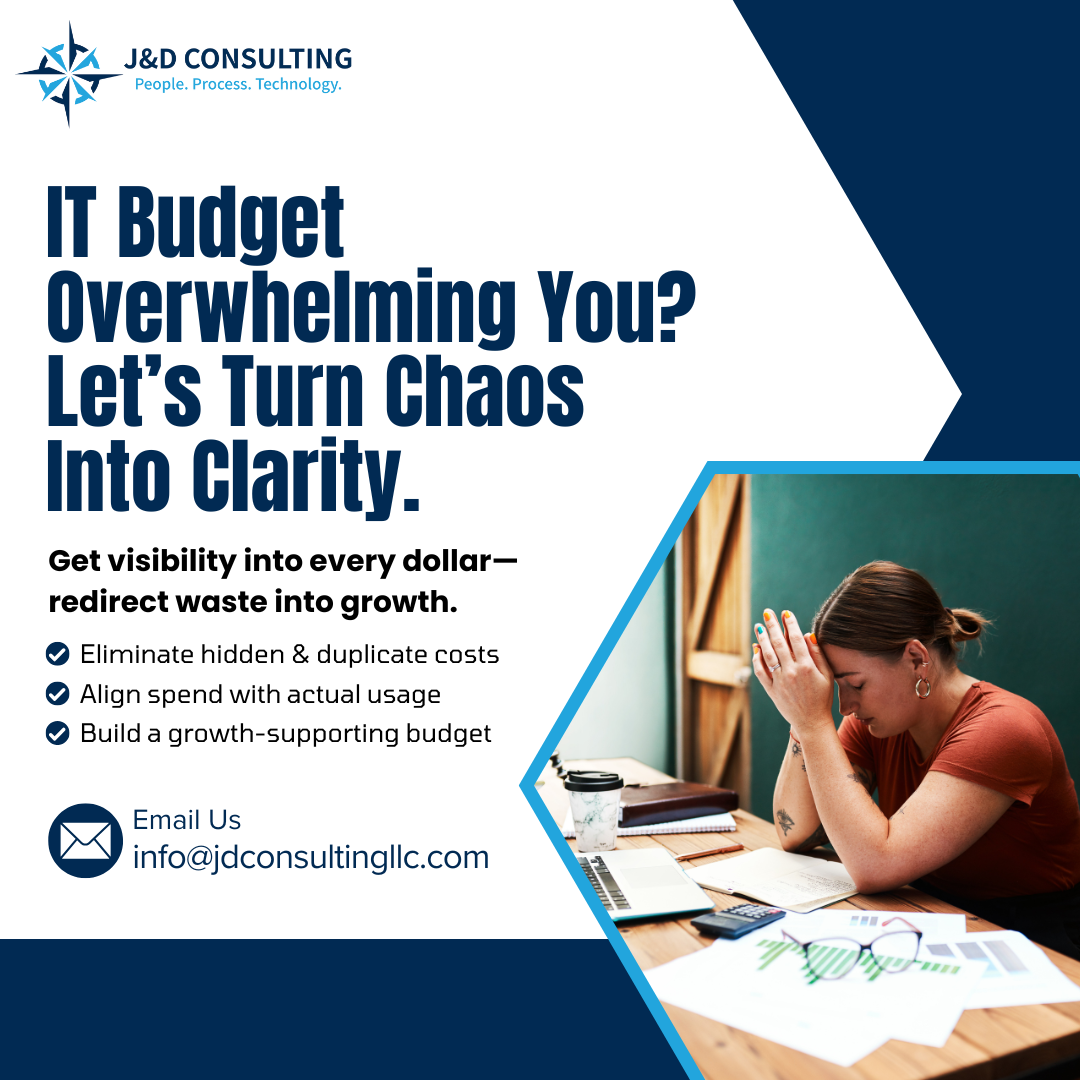Unlocking ROI: Measuring the Impact of Strategic IT Investments
Technology is no longer just a support function—it’s a strategic driver of growth, innovation, and competitive advantage. But as IT budgets continue to rise, so does the pressure to prove return on investment (ROI). The big question is: How can organizations ensure their IT spending delivers measurable business value?At JD Consulting LLC, we help clients align their IT investments with core business goals and implement frameworks that make ROI tracking clear and actionable. In this blog, we’ll walk you through how to unlock ROI from your IT initiatives and measure the impact effectively.
Why ROI in IT Matters More Than Ever
Strategic IT investments can:
- Improve operational efficiency
- Enable data-driven decisions
- Enhance customer experiences
- Support scalability and agility
But without measurable outcomes, even the best initiatives can appear as sunk costs. That’s why ROI must be a built-in metric, not an afterthought. For CFOs, CIOs, and decision-makers, it’s crucial to ask: Is this IT project solving a real business problem?

Step 1: Define Success with Business-Centric Goals
Too often, IT projects are evaluated solely by technical deliverables—like system uptime or feature completion. Instead, start with business outcomes.
Example:
- Technical Goal: Deploy a CRM system
- Strategic Goal: Increase customer retention by 15% through improved engagement
Tie every IT investment to a clear business objective. Whether it’s revenue growth, cost reduction, risk mitigation, or customer satisfaction, align your project KPIs accordingly.
Step 2: Choose the Right ROI Metrics
Measuring ROI in IT goes beyond dollars saved. Here are key metrics to consider:
| Metric | What It Measures | Why It Matters |
|---|---|---|
| Cost Savings | Reduction in labor, software, or hardware costs | Tangible financial ROI |
| Productivity Gains | Time saved by automation or streamlined processes | Efficiency improvements |
| Revenue Growth | Increased sales or upsell opportunities via tech tools | Top-line impact |
| Risk Reduction | Fewer security incidents, compliance issues | Protects long-term value |
| Customer Experience Metrics | NPS, CSAT, churn rates | Retention and loyalty outcomes |
Tools like Power BI, Google Data Studio, or even custom dashboards can help you track and visualize this data over time.
Step 3: Use a Strategic Framework (Like P.I.E.S.)
JD Consulting often applies the P.I.E.S. framework when helping clients assess IT impact:
- Problem Solved: What issue does the IT investment address?
- Impact Created: What has improved? (metrics, testimonials, outcomes)
- Evidence Presented: What data backs the results?
- Solution Justified: How does this solution justify future investment?
This framework ensures your ROI story is not just about numbers—but about narrative and context, which are essential for buy-in from stakeholders.
Step 4: Factor in Time and Risk
ROI doesn’t always happen immediately. Some IT projects, like cloud migration or ERP integration, show value over months or even years.Build a realistic ROI timeline, including:
- Short-term wins (e.g., reduced downtime)
- Mid-term benefits (e.g., better data analytics)
- Long-term gains (e.g., new revenue channels)
Also, include risk-adjusted ROI—accounting for factors like potential breaches, vendor issues, or tech debt. This approach gives a more accurate, strategic view of value.
Step 5: Optimize and Iterate
Post-implementation, continuously revisit your IT investments:
- Are tools being fully adopted?
- Are business outcomes improving?
- Can anything be automated, integrated, or enhanced?
Use ROI insights not just to prove success, but to optimize and innovate. At JD Consulting, we help businesses move from static IT performance to continuous improvement models.
Real-World Example: IT Investment in Action
A mid-sized healthcare client partnered with JD Consulting to overhaul their patient data management system. Here’s how ROI was unlocked:
- Problem: Manual processes and data silos were slowing down patient onboarding and billing
- Solution: Implemented a HIPAA-compliant cloud-based patient management system
- Measured Impact:
- Reduced onboarding time by 35%
- Decreased billing errors by 50%
- Increased patient satisfaction scores by 20%
- ROI: Achieved a 4.5x return in under 12 months
This example highlights how aligning IT with operational goals and patient experience unlocked both financial and strategic value.
Final Thoughts: IT ROI is About More Than Just Numbers
When IT strategy is treated as a business strategy, ROI becomes a guiding light—not a guessing game. By defining goals, choosing the right metrics, applying frameworks like P.I.E.S., and continually refining your approach, you can unlock the true value of your technology investments.At JD Consulting, we don’t just help you implement IT solutions—we help you prove their worth.
